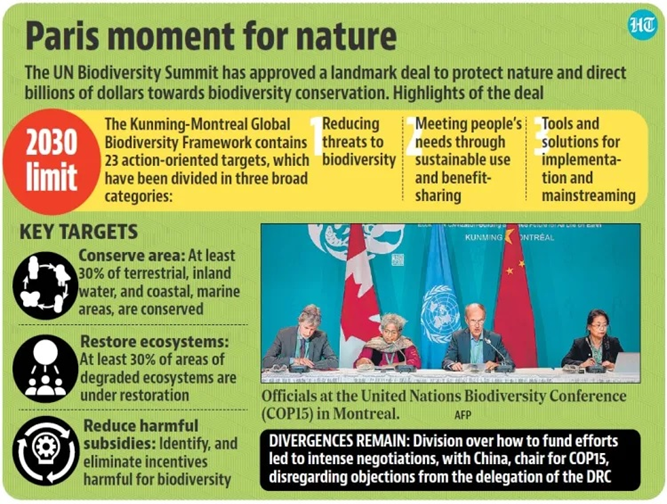Why in News?
In line with the Kunming-Montreal Global Biodiversity Framework (KM-GBF), India has submitted its National Biodiversity Strategy and Action Plan (NBSAP) with 23 specific national biodiversity targets.
The strategy is designed to address pressing challenges in biodiversity conservation and sustainable development.
What’s in Today’s Article?
- Overview of the KM-GBF
- India’s National Biodiversity Strategy and Action Plan (NBSAP)
- Conclusion
Overview of the KM-GBF:

- KM-GBF was adopted by 196 countries during the 15th meeting of the 2022 UN Biodiversity Conference of the Parties (COP 15) in Montreal, Canada.
- Promoted as the "Post-2020 Global Biodiversity Framework"/ the "Paris Agreement for Nature", it aims to halt and reverse biodiversity loss by 2030.
- This historic framework, which includes 4 goals for 2050 and 23 targets for 2030, supports the achievement of the Sustainable Development Goals (SDGs).
- In adopting the KM-GBF, all Parties committed to setting national targets to implement it, while all other actors have been invited to develop and communicate their own commitments.
India’s National Biodiversity Strategy and Action Plan (NBSAP):
- Background:
- Home to nearly 8% of the world's known plant and animal species, India hosts 3,532 fish species, 450 amphibian species, 738 reptilian species, 1,346 bird species, and 436 mammal species.
- At the ongoing 16th Convention on Biological Diversity (COP-16) in Colombia, India has presented its ambitious financial roadmap for biodiversity and conservation.
- India's commitment to reducing threats to biodiversity:
- India’s plan includes restoring at least 30% of degraded ecosystems, covering terrestrial, inland water, marine, and coastal areas.
- This restoration effort is intended to enhance biodiversity, ecosystem functions, ecological integrity, and connectivity.
- Objectives of NBSAP: India’s NBSAP aligns with the KM-GBF's three primary goals:
- Reducing threats to biodiversity.
- Meeting people’s needs through sustainable use and benefit-sharing.
- Providing tools and solutions for implementation and mainstreaming.
- Key features of NBSAP:
- The NBSAP establishes a comprehensive framework focused on conservation, sustainable use, and benefit-sharing.
- It addresses significant national challenges, including:
- Water crisis
- Food insecurity
- Human-wildlife conflicts
- Pollution and emerging diseases
- Disaster risk
- Core targets of NBSAP: Eight of the 23 targets focus specifically on reducing threats to biodiversity, with areas such as:
- Land and sea use changes.
- Pollution and climate change.
- Managing invasive alien species.
- Invasive species management: To mitigate the impact of invasive alien species, India’s action plan includes the following measures:
- Pathway management to prevent species introductions.
- Eradication/control efforts in priority areas, such as islands.
- Quarantine and database development to monitor and control invasive species.
- Financial requirements:
- Achieving these biodiversity targets requires substantial financial investment.
- India has undertaken assessments to track biodiversity-related expenditures:
- Average annual biodiversity expenditure from 2017-18 to 2021-22: Rs 32,207.13 crore.
- Projected annual expenditure for 2024-25 to 2029-30: Rs 81,664.88 crore.
- With significant spending projected for 2025-2030, the nation emphasises the need for international financial support to achieve its biodiversity targets under the KMGBF.
Conclusion:
- India’s NBSAP at COP-16 demonstrates a strong commitment to conserving biodiversity, in alignment with global goals under the KM-GBF.
- Through strategic action, financial investment, and a focus on sustainable practices, India aims to contribute meaningfully to a nature-positive world by 2030.
- Achieving these targets will require a blend of national efforts and international support in the form of finance, technology, and capacity-building resources.










